2017 NISSAN MAXIMA sensor
[x] Cancel search: sensorPage 9 of 406
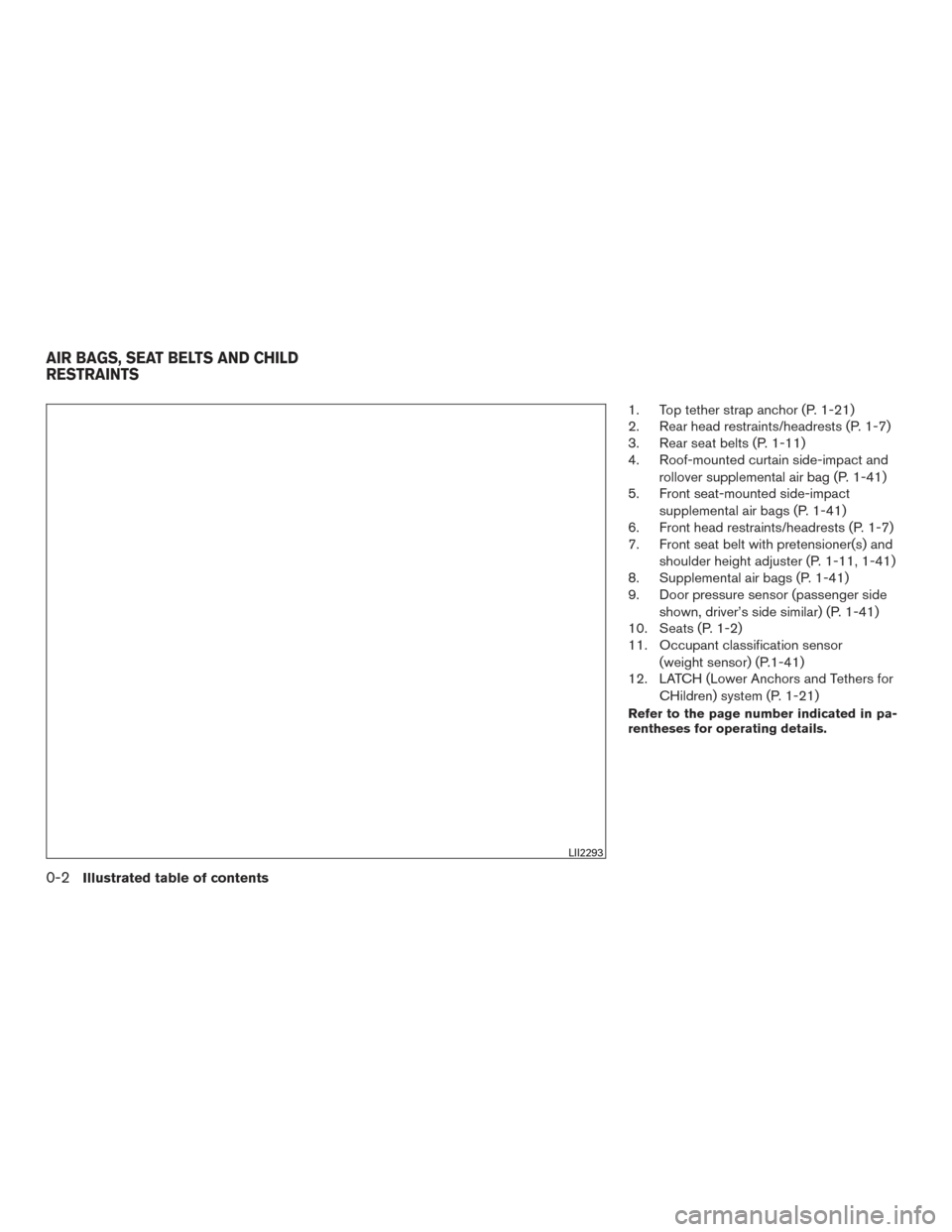
1. Top tether strap anchor (P. 1-21)
2. Rear head restraints/headrests (P. 1-7)
3. Rear seat belts (P. 1-11)
4. Roof-mounted curtain side-impact androllover supplemental air bag (P. 1-41)
5. Front seat-mounted side-impact
supplemental air bags (P. 1-41)
6. Front head restraints/headrests (P. 1-7)
7. Front seat belt with pretensioner(s) and
shoulder height adjuster (P. 1-11, 1-41)
8. Supplemental air bags (P. 1-41)
9. Door pressure sensor (passenger side
shown, driver’s side similar) (P. 1-41)
10. Seats (P. 1-2)
11. Occupant classification sensor
(weight sensor) (P.1-41)
12. LATCH (Lower Anchors and Tethers for
CHildren) system (P. 1-21)
Refer to the page number indicated in pa-
rentheses for operating details.
LII2293
AIR BAGS, SEAT BELTS AND CHILD
RESTRAINTS
0-2Illustrated table of contents
Page 10 of 406
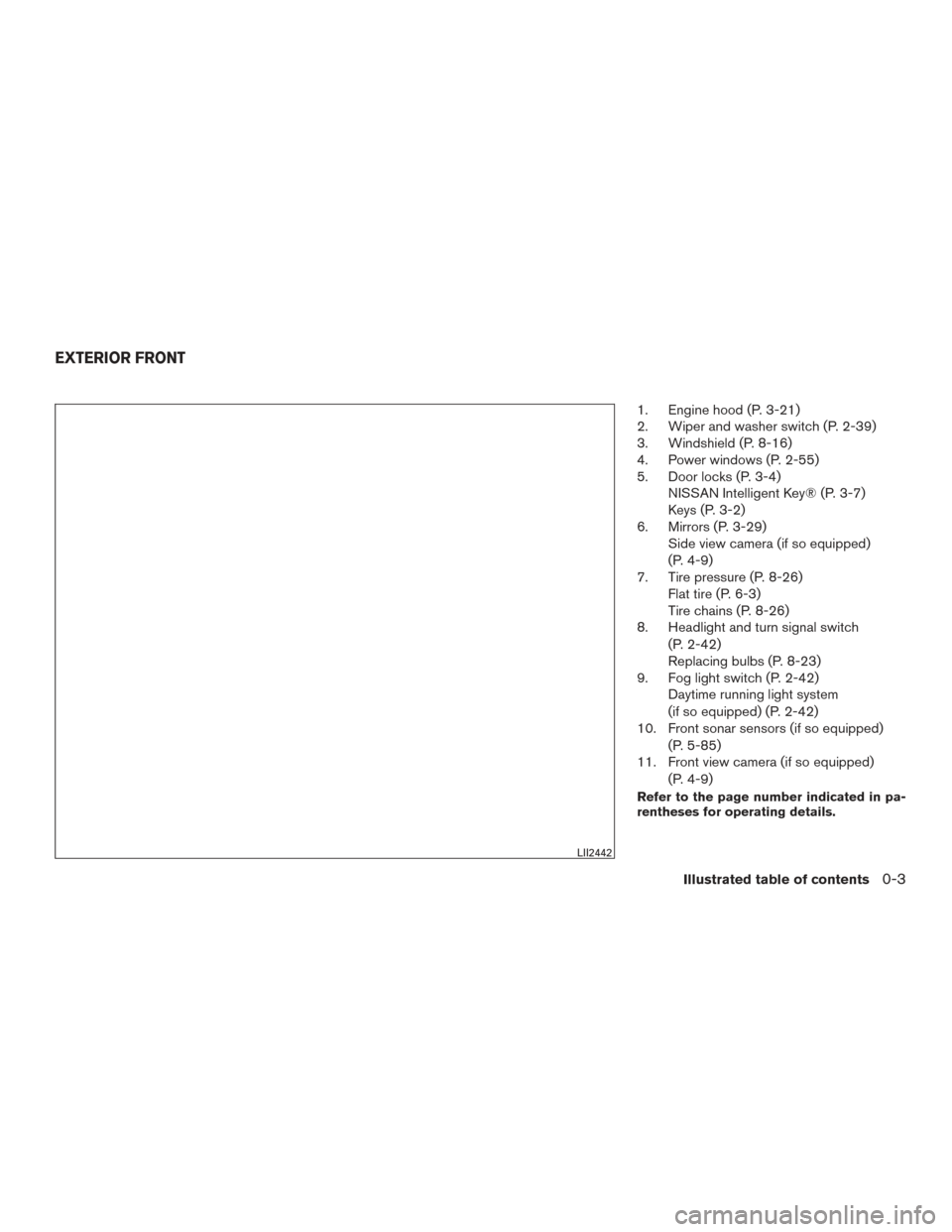
1. Engine hood (P. 3-21)
2. Wiper and washer switch (P. 2-39)
3. Windshield (P. 8-16)
4. Power windows (P. 2-55)
5. Door locks (P. 3-4)NISSAN Intelligent Key® (P. 3-7)
Keys (P. 3-2)
6. Mirrors (P. 3-29) Side view camera (if so equipped)
(P. 4-9)
7. Tire pressure (P. 8-26) Flat tire (P. 6-3)
Tire chains (P. 8-26)
8. Headlight and turn signal switch
(P. 2-42)
Replacing bulbs (P. 8-23)
9. Fog light switch (P. 2-42) Daytime running light system
(if so equipped) (P. 2-42)
10. Front sonar sensors (if so equipped)
(P. 5-85)
11. Front view camera (if so equipped)
(P. 4-9)
Refer to the page number indicated in pa-
rentheses for operating details.
LII2442
EXTERIOR FRONT
Illustrated table of contents0-3
Page 11 of 406
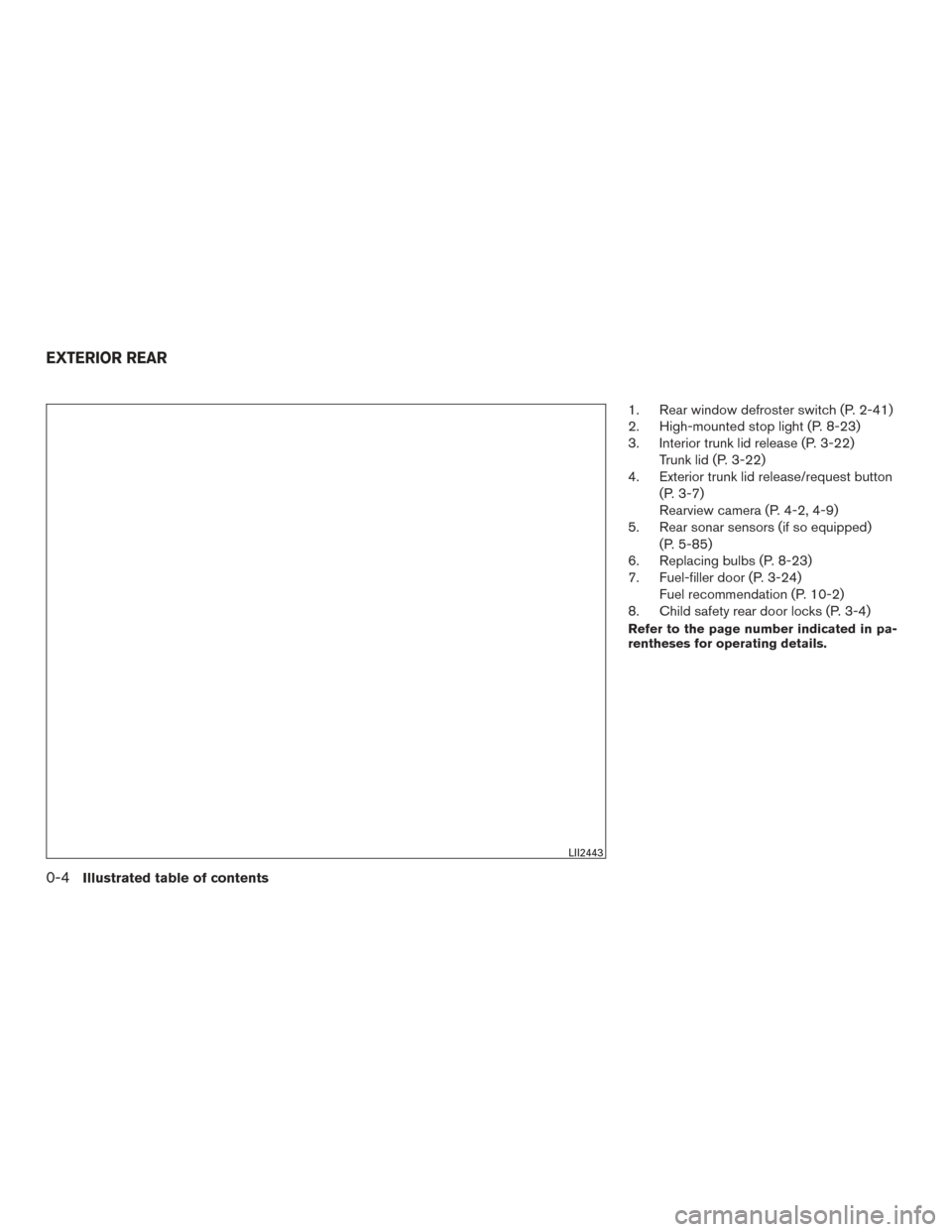
1. Rear window defroster switch (P. 2-41)
2. High-mounted stop light (P. 8-23)
3. Interior trunk lid release (P. 3-22)Trunk lid (P. 3-22)
4. Exterior trunk lid release/request button
(P. 3-7)
Rearview camera (P. 4-2, 4-9)
5. Rear sonar sensors (if so equipped)
(P. 5-85)
6. Replacing bulbs (P. 8-23)
7. Fuel-filler door (P. 3-24) Fuel recommendation (P. 10-2)
8. Child safety rear door locks (P. 3-4)
Refer to the page number indicated in pa-
rentheses for operating details.
LII2443
EXTERIOR REAR
0-4Illustrated table of contents
Page 59 of 406
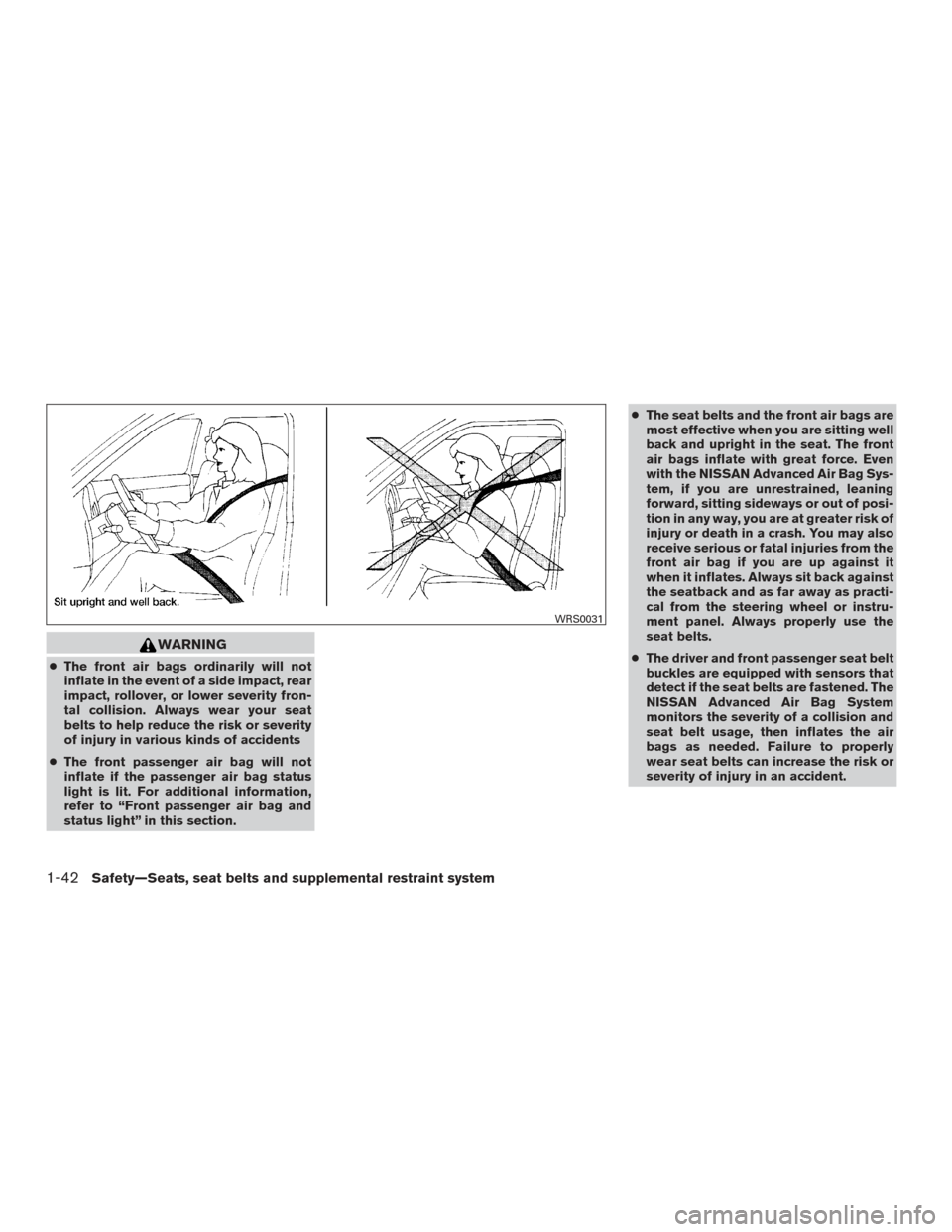
WARNING
●The front air bags ordinarily will not
inflate in the event of a side impact, rear
impact, rollover, or lower severity fron-
tal collision. Always wear your seat
belts to help reduce the risk or severity
of injury in various kinds of accidents
● The front passenger air bag will not
inflate if the passenger air bag status
light is lit. For additional information,
refer to “Front passenger air bag and
status light” in this section. ●
The seat belts and the front air bags are
most effective when you are sitting well
back and upright in the seat. The front
air bags inflate with great force. Even
with the NISSAN Advanced Air Bag Sys-
tem, if you are unrestrained, leaning
forward, sitting sideways or out of posi-
tion in any way, you are at greater risk of
injury or death in a crash. You may also
receive serious or fatal injuries from the
front air bag if you are up against it
when it inflates. Always sit back against
the seatback and as far away as practi-
cal from the steering wheel or instru-
ment panel. Always properly use the
seat belts.
● The driver and front passenger seat belt
buckles are equipped with sensors that
detect if the seat belts are fastened. The
NISSAN Advanced Air Bag System
monitors the severity of a collision and
seat belt usage, then inflates the air
bags as needed. Failure to properly
wear seat belts can increase the risk or
severity of injury in an accident.
WRS0031
1-42Safety—Seats, seat belts and supplemental restraint system
Page 60 of 406
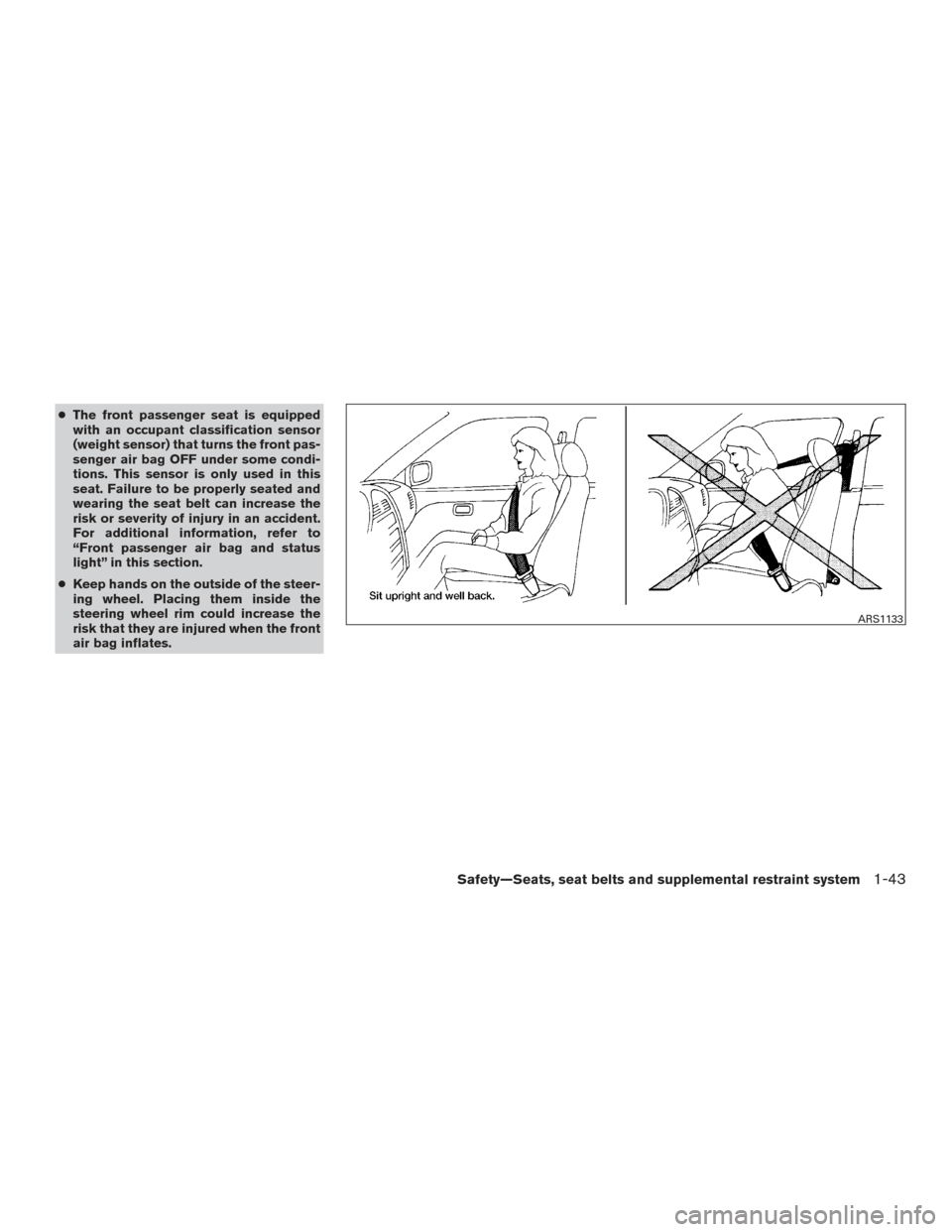
●The front passenger seat is equipped
with an occupant classification sensor
(weight sensor) that turns the front pas-
senger air bag OFF under some condi-
tions. This sensor is only used in this
seat. Failure to be properly seated and
wearing the seat belt can increase the
risk or severity of injury in an accident.
For additional information, refer to
“Front passenger air bag and status
light” in this section.
● Keep hands on the outside of the steer-
ing wheel. Placing them inside the
steering wheel rim could increase the
risk that they are injured when the front
air bag inflates.
ARS1133
Safety—Seats, seat belts and supplemental restraint system1-43
Page 65 of 406

NISSAN Advanced Air Bag System
(front seats)
1. Roof-mounted curtain side-impact and roll-over supplemental air bag inflators
2. Roof-mounted curtain side-impact and roll- over supplemental air bags
3. Front seat-mounted side-impact supple- mental air bag modules
4. Air bag Control Unit (ACU)
5. Supplemental front-impact air bag modules
6. Crash zone sensor
7. Occupant classification system control unit
8. Occupant classification sensor (weight sen- sor)
9. Seat belt buckle switches for driver’s and front passenger’s side
10. Seat belt with pretensioner(s) (front seats)
11. Side satellite sensor
LRS2788
1-48Safety—Seats, seat belts and supplemental restraint system
Page 66 of 406
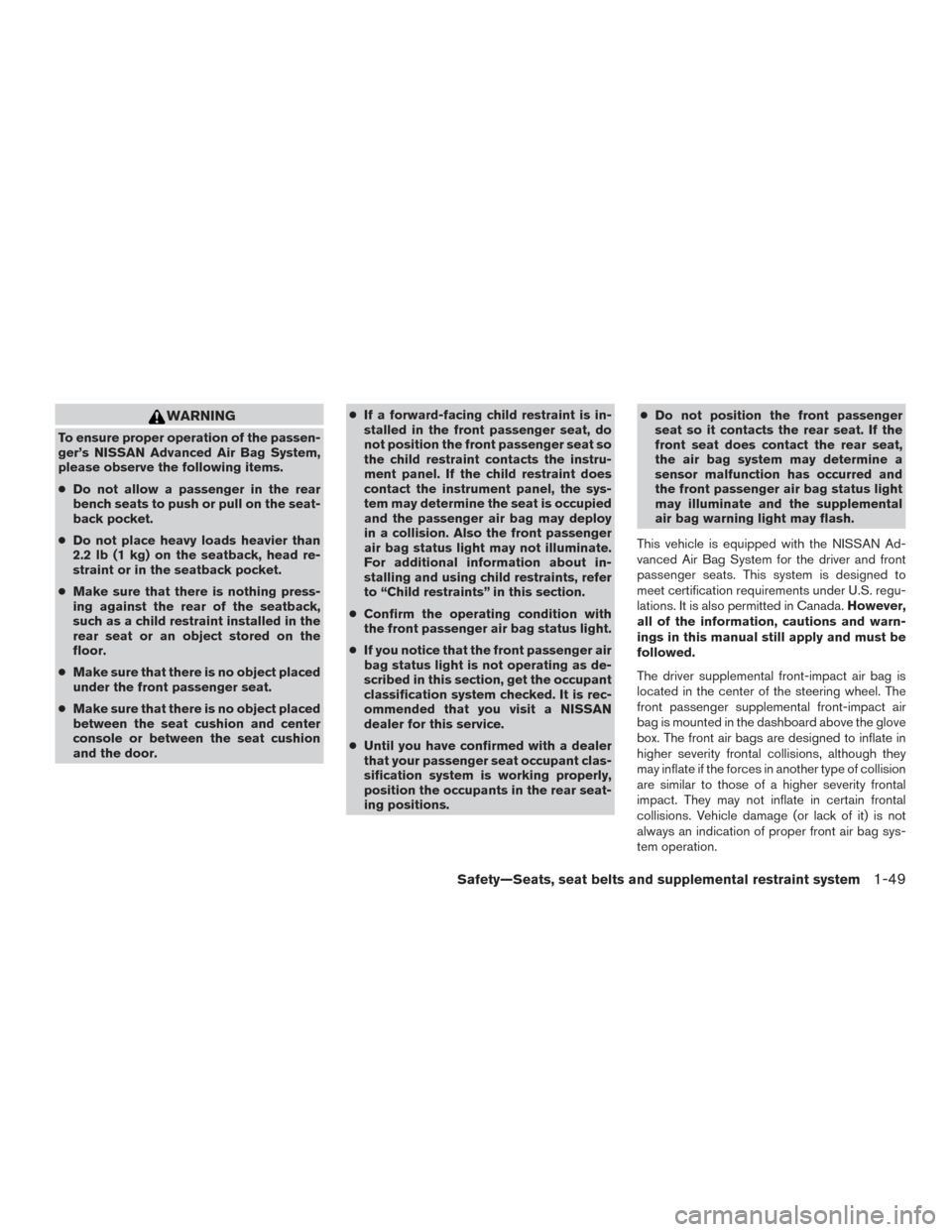
WARNING
To ensure proper operation of the passen-
ger’s NISSAN Advanced Air Bag System,
please observe the following items.
●Do not allow a passenger in the rear
bench seats to push or pull on the seat-
back pocket.
● Do not place heavy loads heavier than
2.2 lb (1 kg) on the seatback, head re-
straint or in the seatback pocket.
● Make sure that there is nothing press-
ing against the rear of the seatback,
such as a child restraint installed in the
rear seat or an object stored on the
floor.
● Make sure that there is no object placed
under the front passenger seat.
● Make sure that there is no object placed
between the seat cushion and center
console or between the seat cushion
and the door. ●
If a forward-facing child restraint is in-
stalled in the front passenger seat, do
not position the front passenger seat so
the child restraint contacts the instru-
ment panel. If the child restraint does
contact the instrument panel, the sys-
tem may determine the seat is occupied
and the passenger air bag may deploy
in a collision. Also the front passenger
air bag status light may not illuminate.
For additional information about in-
stalling and using child restraints, refer
to “Child restraints” in this section.
● Confirm the operating condition with
the front passenger air bag status light.
● If you notice that the front passenger air
bag status light is not operating as de-
scribed in this section, get the occupant
classification system checked. It is rec-
ommended that you visit a NISSAN
dealer for this service.
● Until you have confirmed with a dealer
that your passenger seat occupant clas-
sification system is working properly,
position the occupants in the rear seat-
ing positions. ●
Do not position the front passenger
seat so it contacts the rear seat. If the
front seat does contact the rear seat,
the air bag system may determine a
sensor malfunction has occurred and
the front passenger air bag status light
may illuminate and the supplemental
air bag warning light may flash.
This vehicle is equipped with the NISSAN Ad-
vanced Air Bag System for the driver and front
passenger seats. This system is designed to
meet certification requirements under U.S. regu-
lations. It is also permitted in Canada. However,
all of the information, cautions and warn-
ings in this manual still apply and must be
followed.
The driver supplemental front-impact air bag is
located in the center of the steering wheel. The
front passenger supplemental front-impact air
bag is mounted in the dashboard above the glove
box. The front air bags are designed to inflate in
higher severity frontal collisions, although they
may inflate if the forces in another type of collision
are similar to those of a higher severity frontal
impact. They may not inflate in certain frontal
collisions. Vehicle damage (or lack of it) is not
always an indication of proper front air bag sys-
tem operation.
Safety—Seats, seat belts and supplemental restraint system1-49
Page 67 of 406
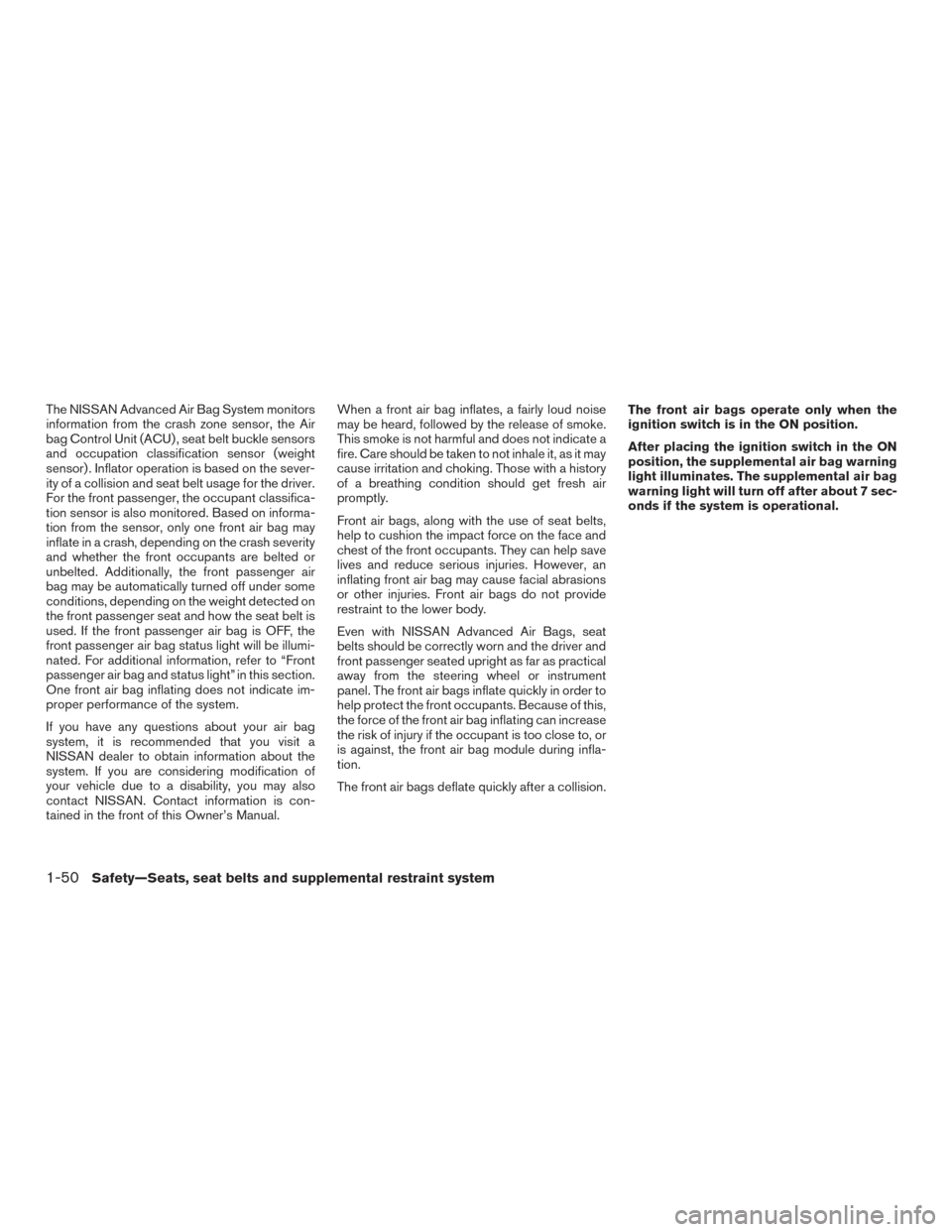
The NISSAN Advanced Air Bag System monitors
information from the crash zone sensor, the Air
bag Control Unit (ACU) , seat belt buckle sensors
and occupation classification sensor (weight
sensor) . Inflator operation is based on the sever-
ity of a collision and seat belt usage for the driver.
For the front passenger, the occupant classifica-
tion sensor is also monitored. Based on informa-
tion from the sensor, only one front air bag may
inflate in a crash, depending on the crash severity
and whether the front occupants are belted or
unbelted. Additionally, the front passenger air
bag may be automatically turned off under some
conditions, depending on the weight detected on
the front passenger seat and how the seat belt is
used. If the front passenger air bag is OFF, the
front passenger air bag status light will be illumi-
nated. For additional information, refer to “Front
passenger air bag and status light” in this section.
One front air bag inflating does not indicate im-
proper performance of the system.
If you have any questions about your air bag
system, it is recommended that you visit a
NISSAN dealer to obtain information about the
system. If you are considering modification of
your vehicle due to a disability, you may also
contact NISSAN. Contact information is con-
tained in the front of this Owner’s Manual.When a front air bag inflates, a fairly loud noise
may be heard, followed by the release of smoke.
This smoke is not harmful and does not indicate a
fire. Care should be taken to not inhale it, as it may
cause irritation and choking. Those with a history
of a breathing condition should get fresh air
promptly.
Front air bags, along with the use of seat belts,
help to cushion the impact force on the face and
chest of the front occupants. They can help save
lives and reduce serious injuries. However, an
inflating front air bag may cause facial abrasions
or other injuries. Front air bags do not provide
restraint to the lower body.
Even with NISSAN Advanced Air Bags, seat
belts should be correctly worn and the driver and
front passenger seated upright as far as practical
away from the steering wheel or instrument
panel. The front air bags inflate quickly in order to
help protect the front occupants. Because of this,
the force of the front air bag inflating can increase
the risk of injury if the occupant is too close to, or
is against, the front air bag module during infla-
tion.
The front air bags deflate quickly after a collision.
The front air bags operate only when the
ignition switch is in the ON position.
After placing the ignition switch in the ON
position, the supplemental air bag warning
light illuminates. The supplemental air bag
warning light will turn off after about 7 sec-
onds if the system is operational.
1-50Safety—Seats, seat belts and supplemental restraint system